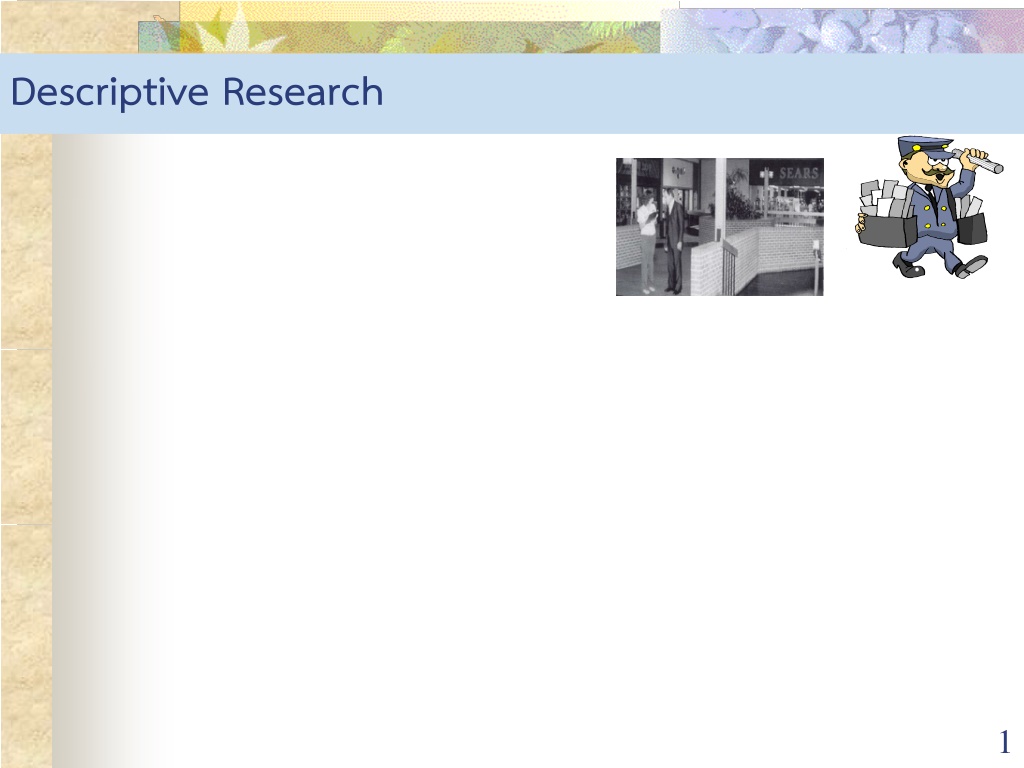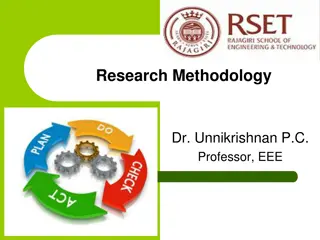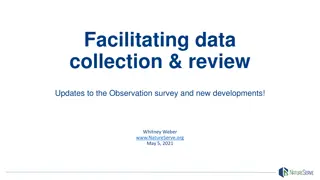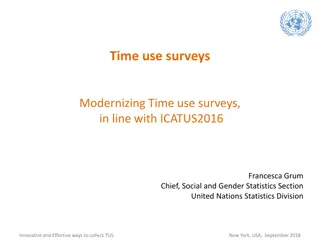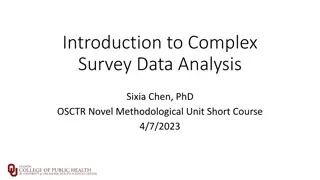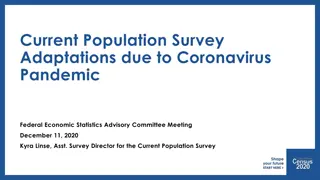Evolution of Survey Research Methods in Data Collection
Descriptive research explores the popularity of surveys to understand consumer behavior, demographic insights, and lifestyle perspectives. The use of different survey modes, such as personal interviews and online surveys, has transformed data collection methods. Advantages and disadvantages of online surveys are discussed, along with a content analysis of television ads in Singapore.
Download Presentation

Please find below an Image/Link to download the presentation.
The content on the website is provided AS IS for your information and personal use only. It may not be sold, licensed, or shared on other websites without obtaining consent from the author.If you encounter any issues during the download, it is possible that the publisher has removed the file from their server.
You are allowed to download the files provided on this website for personal or commercial use, subject to the condition that they are used lawfully. All files are the property of their respective owners.
The content on the website is provided AS IS for your information and personal use only. It may not be sold, licensed, or shared on other websites without obtaining consent from the author.
E N D
Presentation Transcript
Popularity of Surveys 1. The need to know why: to understand why people do or do not do something? 2. The need to know how: to understand the process consumers go through before taking action 3. The need to know who: To know who the person is from a demographic or lifestyle perspective 2
Survey and Mode of Admin. Personal interview In-home or Mall-intercept Mail interview Mail Electronic interview Email & Internet 3
Survey Types (Mode of Admin) Telephone Traditional CATI 4
The Internet Has Changed Survey Research Advantages of Online Surveys Real Time Reporting Dramatically Reduced Costs Readily Personalized High response rates Contact the Hard-to-Reach 6
The Internet Has Changed Survey Research Disadvantages of Online Surveys Internet users are not representative of the population as a whole Security on the Internet 7
TELEVISION ADS IN SINGAPORE: A CONTENT ANALYSIS SHARAF N. REHMAN Franklin College, Lugano, Switzerland ANNETTE AW Nanyang Technological Univ., Singapore WILLIAM KENNAN Radford University, VA 8
TELEVISION ADS IN SINGAPORE: A CONTENT ANALYSIS (2) INTRODUCTION: The goal of this paper is to appraise the information content of Singapore television advertising and to make a comparison with relevant United States findings. Research reported in this paper is a replication of two empirical studies of the informational content of television advertising content in the United States by Resnik and Stern (1977) and Stern, Resnik, and Grubb (1977). 9
TELEVISION ADS IN SINGAPORE: A CONTENT ANALYSIS (2) METHODOLOGY the author analyzed television commercials on Channel 5 (the English channel) in Singapore. One week of prime-time (7:00 PM - 11:00 PM) programming was recorded in March of 1996. Since the purpose of the study was to analyze the informational content and not their recall and retention, repeated ads were excluded from the study. 103 ads were included in the study. 10
TELEVISION ADS IN SINGAPORE: A CONTENT ANALYSIS (2) RESULTS In our sample of 103 commercials, 29 (28%) advertised food and beverages. Service and retailing are the second most common type of TV commercials (24%), Durable products are the third most commonly advertised (21%) on television. Various product categories advertised on Singapore television are shown in Table 1. 11
TELEVISION ADS IN SINGAPORE: A CONTENT ANALYSIS (2) TABLE 1: PRODUCT CATEGORIES ADVERTISED ON THE ENGLISH CHANNEL IN SINGAPORE Fq 29 25 22 12 4 4 4 2 1 103 Product Category % 28.16 24.27 21.36 11.65 3.88 3.88 3.88 1.94 .97 100 Food and Beverages Service and Retailing Durable Products Cosmetics Non-durable Products Insurance Real Estate Concerts/Exhibitions Liquor 12 TOTAL
TELEVISION ADS IN SINGAPORE: A CONTENT ANALYSIS (2) CONCLUSIONS US:food, personalcareproducts, and institutionaladsaccountfor 69% of the TV ads. Singapore:thesecategoriesrepresent 71% of TV ads. Only 46 percent of the US adswereinformativewhereas 76% of theadsinthesecategorieswereinformative. Whilehalf of televisionadvertisinginthe United States is informative, theotherhalfseemstofocusonemotionalappeal and lifestyle. whereas, a higherinformativecontentinSingapore. 13
TELEVISION ADS IN SINGAPORE: A CONTENT ANALYSIS (2) Limitation Thisstudyfocusedononlyone of theninechannels availableinSingapore. Channel 5 wasselectedbecauseit broadcastsintheEnglishlanguage. The advertisingin Chinese, Malay, orTamilchannelsmaytell a differentstory. Thisauthorrecommends a replication of thisstudyusing severalchannels. A similarresearchmodelappliedtothe analysis of emotional and lifestyletypeadsmayalso rendernewinsightsintoconsumerbehavior. 14
Direct Observation of Purchasing Behavior WILLIAM D. WELLS and LEONARD A. LO SCIUTO* 15
Direct Observation of Purchasing Behavior What people do are not the same as what they say Occasionally produces an idea that can be tested later. What, But Not Why Sampling Problem Qualitative Data 16
Direct Observation of Purchasing Behavior Composition of the Shopper Population Because most marketing research consists of interviews with housewives, one can easily get the impression that most supermarket shopping is done by housewife 17
Direct Observation of Purchasing Behavior: Result Womendomore of thefamilyshoppingthanmen, butmendo enough of ittowarrantthemarketer'sattention. Husbandsaccompanyingwivesalmostalwaysinfluencepurchase decisionswhentheytry. Children, especiallysuburbanchildren, arealsoquiteinfluential, althoughtheamount of influencevariesfromproducttoproduct. Priceconsciousnessvariesaccordingtotype of product. Priceconsciousnessseemstobeslightlymorecharacteristic of womenthan of men. Manyshoppers of alltypesinspectpackagescarefullybeforethey buy. 18
